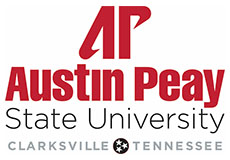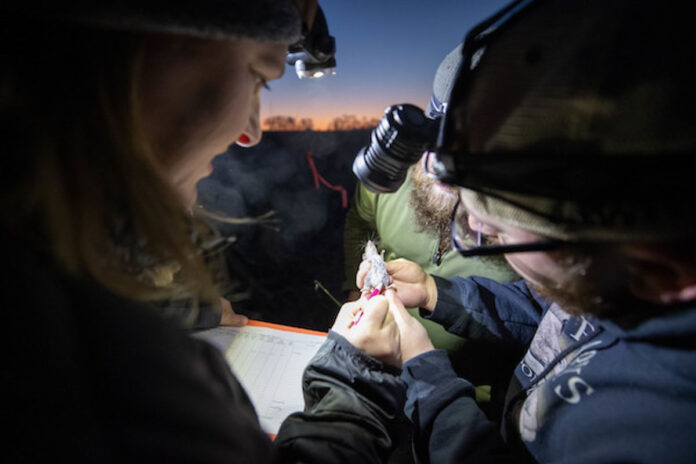 Clarksville, TN – Dunbar Cave State Park’s restored prairie is home to a wide variety of animal species, and students, faculty, and staff from Austin Peay State University (APSU) are gathering valuable information about them through live small mammal trapping.
Clarksville, TN – Dunbar Cave State Park’s restored prairie is home to a wide variety of animal species, and students, faculty, and staff from Austin Peay State University (APSU) are gathering valuable information about them through live small mammal trapping.
Dr. Catherine Haase, assistant professor in the department of biology, said the trapping is part of an ongoing study on how different species have responded to native grassland restoration efforts in the Clarksville area.
“We’ll be using the data long-term to look at population trends of small mammals, as well as their response to restoration,” she said. “But the main driver for me is that it benefits our students. We really need them to be out there getting different types of hands-on and data collection experience, and having the opportunity for small mammal trapping means that any time someone’s interested in that I can send them out.”
Seventeen students from assistant professor Dr. Evan Rehm’s ecology class were given that opportunity on March 22nd, and they spent the morning checking small box traps and recording data. They also learned how to handle live animals with the proper permits and supervision.
“I want the students to get excited about ecology, and oftentimes the hands-on experience is worth so much more than time in the classroom,” Rehm said. “To be able to come out and use the same techniques that professionals are using for long-term data management and monitoring ties in really nicely with what we’re learning.”
Junior biology major Brooke Freeman said she appreciated the chance to learn about different trapping methods and gain practical experience in the field.
“For a while I was going to be a lab technician, and this is a way for me to feel out field work and compare it to lab work,” she said. “As I’m getting further along in my education and having experiences like this, it shows me that maybe I could trap, do field work, take data from animals and have a really hands-on experience.”
According to Haase, the department uses Sherman box-style traps baited with oat and peanut butter treats to attract small mammals. Wildlife technicians open the traps five evenings a week before returning the next morning to check them and record data.
Each animal is then weighed, tagged and checked for sex and reproductive conditions, and the information is recorded using data sheets. Haase plans to repeat the process over six-week periods every fall and spring semester.
“We initially came out here with Dr. Haase and scoped out an area, then came back to set up traps in a grid,” Austin Peay State University wildlife technician Dakota Van Parys said, noting that the first traps were placed in Fall 2022. “A week prior to starting trapping, we seeded each location to see if we could attract more mammals than last semester, and we definitely have.”
Van Parys said the Sherman traps have captured hispid cotton rats and deer mice so far. He and fellow wildlife technician Kennedy Beck have also set up multiple bat monitors and motion-activated game cameras to record larger mammals, such as bobcats and foxes, without having to trap them.
“Deer mice are some of the most common mammals here, and there are two species we tend to see: North American and white-footed,” Haase said. “They can be difficult to tell apart in the field, so having measurements helps us go back and look up which one’s which … rodents are [also] a great way to learn how to handle animals because they’re pretty hardy, they’re small and they’re not going to hurt you if they bite you.”
Senior biology major Dalon Gadson handled a deer mouse for the first time during the ecology class’s trip to Dunbar Cave, and he said learning how to safely pick up small mammals was an opportunity for growth.
“It was honestly scary for me, because little animals seem more dangerous,” he said. “I can see a cow or a bull in front of me and know that it’s going to charge [if it’s upset], but a mouse can bite you, crawl in your shirt or poke your eye – you don’t know. I thought it was cool to actually hold [the mouse] and face my fear.”
Haase said being able to handle the rodents also allows researchers to tag them and estimate the total population. One of her goals for small mammal trapping is to build long-term data sets that can answer a variety of research questions.
“Doing a single year of trapping doesn’t really give us a lot of information, so we’re establishing a long-term plot here and hoping to trap this and [three] other areas every spring and fall,” she said, adding that game cameras and bat monitors have also been installed at the other locations.
The areas being surveyed were determined in partnership with the Southeastern Grasslands Institute, a nonprofit organization cofounded by Austin Peay State University professor of biology Dr. Dwayne Estes. Each site represents a different stage of conservation, allowing researchers to gather more effective data.
“We have Dunbar, which was restored about five years ago,” Haase said. “We also have a site up by Guthrie which is a remnant grassland, meaning it’s always been there. And there’s a site at the Google property north of town … they restored one section around 2019, and there’s also a [currently] unrestored section so we have that sort of pre-restoration snapshot.”
Beck said she enjoyed setting up the different trapping methods at each site, and she looks forward to continuing the research in the months ahead.
[470cneter]
“I think it’s been a great experience,” she said. “It was honestly the highlight of when I was in school, because I started doing this in my senior year. It’s just kind of carried over and sparked my love and interest for wildlife.”



